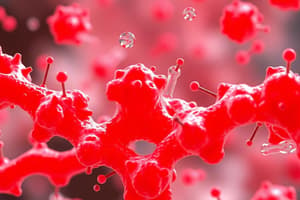Podcast
Questions and Answers
What is the optimum temperature for enzyme activity in the human body?
What is the optimum temperature for enzyme activity in the human body?
- 25°C
- 100°C
- 50°C
- 37°C (correct)
Higher temperatures always enhance enzyme activity.
Higher temperatures always enhance enzyme activity.
False (B)
What happens to enzymes when they become denatured?
What happens to enzymes when they become denatured?
They lose their shape and active site, resulting in a loss of activity.
Diffusion is the net movement of particles from a region of ______ concentration to a region of ______ concentration.
Diffusion is the net movement of particles from a region of ______ concentration to a region of ______ concentration.
Match the following concepts with their definitions:
Match the following concepts with their definitions:
Which factor increases the rate of diffusion of gases in living organisms?
Which factor increases the rate of diffusion of gases in living organisms?
Active transport requires energy to move substances across membranes.
Active transport requires energy to move substances across membranes.
Why is diffusion important for gas exchange in the lungs?
Why is diffusion important for gas exchange in the lungs?
What is the primary function of root hair cells in plants?
What is the primary function of root hair cells in plants?
Proteins are made up of only carbon, hydrogen, and oxygen.
Proteins are made up of only carbon, hydrogen, and oxygen.
Which chemical elements make up fats?
Which chemical elements make up fats?
Starch is made from __________.
Starch is made from __________.
Match the biochemical test with its corresponding positive result:
Match the biochemical test with its corresponding positive result:
What happens to a plant cell in pure water?
What happens to a plant cell in pure water?
Diffusion moves particles from an area of lower concentration to an area of higher concentration.
Diffusion moves particles from an area of lower concentration to an area of higher concentration.
What term describes a cell that has shrunk due to loss of water?
What term describes a cell that has shrunk due to loss of water?
Oxygen diffuses from the alveoli of the lungs into __________.
Oxygen diffuses from the alveoli of the lungs into __________.
Which factor does NOT influence the rate of diffusion?
Which factor does NOT influence the rate of diffusion?
Flashcards
Optimum Temperature for Enzymes
Optimum Temperature for Enzymes
The temperature at which enzymes work fastest. For human enzymes, this is 37°C.
Enzyme Denaturation
Enzyme Denaturation
When heat breaks bonds in an enzyme, changing its shape and making it unable to function.
Diffusion
Diffusion
The movement of particles from a high concentration to a low concentration area.
Diffusion Rate and Surface Area
Diffusion Rate and Surface Area
Signup and view all the flashcards
Diffusion and Temperature
Diffusion and Temperature
Signup and view all the flashcards
Diffusion and Concentration Gradient
Diffusion and Concentration Gradient
Signup and view all the flashcards
Gaseous Exchange in Lungs (Diffusion)
Gaseous Exchange in Lungs (Diffusion)
Signup and view all the flashcards
Active Transport
Active Transport
Signup and view all the flashcards
Monomer
Monomer
Signup and view all the flashcards
Polymer
Polymer
Signup and view all the flashcards
Carbohydrates
Carbohydrates
Signup and view all the flashcards
Proteins
Proteins
Signup and view all the flashcards
Fats
Fats
Signup and view all the flashcards
Osmosis
Osmosis
Signup and view all the flashcards
Turgid (plant cell)
Turgid (plant cell)
Signup and view all the flashcards
Plasmolysed (plant cell)
Plasmolysed (plant cell)
Signup and view all the flashcards
Diffusion in lungs
Diffusion in lungs
Signup and view all the flashcards
Study Notes
Enzyme Activity and Temperature
- Enzymes function optimally at a specific temperature.
- For the human body, this optimum is 37°C.
- High temperatures disrupt the bonds holding the enzyme together, causing it to lose its shape (denaturation).
- Lower temperatures decrease the kinetic energy of enzymes and substrates, leading to fewer collisions, reduced activity, and fewer products.
- Enzyme activity increases with rising temperature until the optimum is reached, then decreases beyond it due to denaturation.
Diffusion
- Diffusion is the movement of particles from high to low concentration due to random motion.
- Substances move into and out of cells via diffusion through the cell membrane.
- Gaseous Exchange in Lungs: Oxygen diffuses from the alveoli (lungs) into red blood cells.
- Gaseous Exchange in Plants: Carbon dioxide diffuses into leaves for photosynthesis, and oxygen diffuses out.
- Factors Affecting Diffusion:
- Larger surface area increases diffusion rate. (e.g., alveoli, root hair cells)
- Higher temperatures speed up particle movement and diffusion.
- A steeper concentration gradient leads to faster diffusion.
Active Transport
- Active transport moves particles against their concentration gradient (low to high).
- This process requires energy from respiration.
- Crucial for transporting molecules and ions across membranes.
- Example: Ion uptake by root hair cells (plant roots absorb ions from low-concentration soil).
Biological Molecules
- Carbohydrates: Carbon, Hydrogen, Oxygen (CHO)
- Proteins: Carbon, Hydrogen, Oxygen, Nitrogen, Sulfur (CHONS)
- Fats: Carbon, Hydrogen, Oxygen (CHO)
- Large molecules (polymers) are built from smaller molecules (monomers).
- Starch and glycogen are made of glucose.
- Proteins are made of amino acids.
- Fats are made of fatty acids and glycerol.
- Examples of Polymers and Monomers:
- Starch (glucose — plants, storage)
- Glycogen (glucose — animals, storage in liver & muscles)
- Cellulose (glucose — plant cell walls, structural)
- Proteins (amino acids — muscle, hair, cell membranes, enzymes like insulin)
- Fats (fatty acids & glycerol — cell membranes, hormone storage, long-term energy)
Biochemical Tests
- Iodine Test for Starch: Orange/yellow → Blue/black (positive)
- Benedict's Test for Glucose: Blue → Brick red (positive)
- Biuret Test for Proteins: Blue → Purple (positive)
- Ethanol Test for Lipids: Colorless → Cloudy (positive)
Osmosis
- Osmosis is the movement of water through a partially permeable membrane from high water potential (dilute solution) to low water potential (concentrated solution).
- Effect on Plant Cells:
- Pure water → Water enters, becomes turgid.
- Same concentration → No net movement, flaccid.
- Concentrated solution → Water leaves, becomes plasmolysed.
- Effect on Animal Cells:
- Pure water → Water enters, becomes lysed (bursts).
- Same concentration → No net movement, normal.
- Concentrated solution → Water leaves, becomes crenated (shrinks).
- Key terms: turgid, flaccid, plasmolysed, osmosis
Studying That Suits You
Use AI to generate personalized quizzes and flashcards to suit your learning preferences.
Description
This quiz covers key concepts related to enzyme activity and diffusion processes in biological systems. Learn how temperature affects enzyme functionality and explore the mechanisms of diffusion in cells, including gas exchange in lungs and plants. Test your understanding of these fundamental biological principles.




